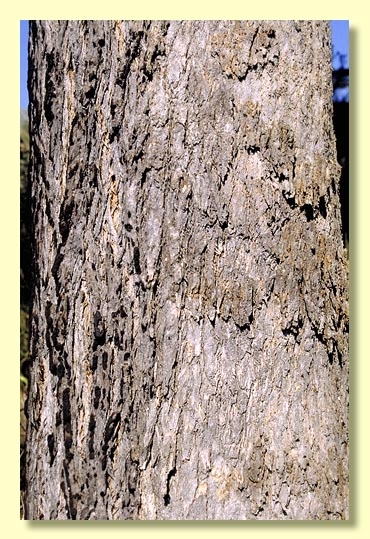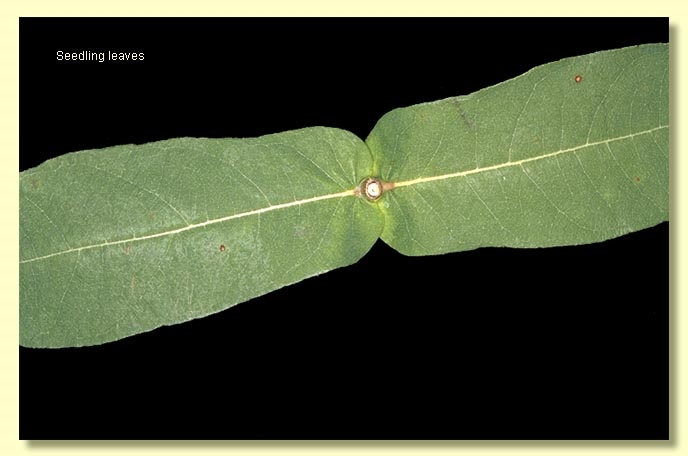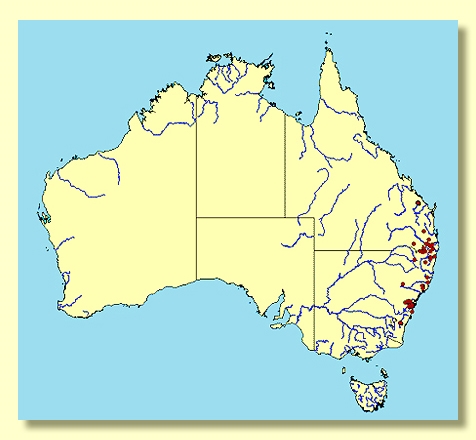Euclid - Online edition
Angophora subvelutina
Angophora
Eucalyptus subvelutina (F.Muell.) Brooker, Austral. Sys. Bot. 13: 137 (2000). T: Burnett & Brisbane Rivers, [Qld.], Dec. 1856, F.Mueller; lecto: MEL, fide G.J.Leach, Telopea 2: 774 (1986).
Medium-sized tree to 20 m tall. Forming a lignotuber.
Bark rough to the small branches, fibrous to flaky, grey. Glands (or ducts) sometimes present in the pith but only seen just below the nodes on young branchlets.
Juvenile growth (coppice or field seedlings to 50 cm): stem rounded in cross-section, pubescent; juvenile leaves opposite, sessile, ovate to elliptical to lanceolate, 5–11 cm long, 2.5–5 cm wide, base amplexicaul, margin entire, apex acute, green, pubescent.
Adult leaves opposite, usually sessile, rarely shortly petiolate, petioles 0–0.2 cm long; blade lanceolate to ovate to elliptical, 6–12 cm long, 2–5 cm wide, undulate, base amplexicaul, rarely lobed or tapering to petiole (when petiolate), margin entire or rarely crenulate, apex acute to rounded, discolorous, glossy green to dull grey-green, penniveined, densely to very densely reticulate, intramarginal vein present, oil glands island or obscure or apparently absent.
Inflorescence terminal compound, peduncles 0.9–3 cm long, buds 3 or 7 per umbel, pedicellate (pedicels 0.4–1 cm long). Mature buds globular (0.4–0.6 cm long, 0.4–0.6 cm wide), hypanthium pubescent, longitudinally ribbed, petals white with a green keel, stamens inflexed, anthers oblong, versatile, dehiscing by longitudinal slits (non-confluent), style long, stigma blunt, mop-like, locules 3 or 4, the placentae each with 5 vertical ovule rows. Flowers white or creamy white.
Fruit pedicellate (pedicels 0.6–1.2 cm long), cup-shaped, (0.6)0.8–1.1 cm long, 0.6–1.1 cm wide, longitudinally ribbed, disc descending, valves 3 or 4, enclosed.
Seeds reddish brown to brown, 5–8 mm long, flattened-ellipsoidal, dorsal surface smooth, hilum ventral.
Cultivated seedlings (measured at ca node 10): cotyledons reniform to orbicular; stems rounded in cross-section, scabrid with bristle-glands and hairs; leaves opposite, sessile (rarely subsessile), elliptic to oblong, 7–10 cm long, 2.5–4.5 cm wide, amplexicaul, margin entire, apex pointed, discolorous, green, scabrid.
Flowering has been recorded in January, February and December.
A. subvelutina is a woodland tree with smaller, softer leaves and smaller buds and fruit than A. robur and A. hispida . A. robur is a small tree with a straggly habit, occurring in New South Wales from north-west of Coffs Harbour, around Glenreagh, to north-west of Grafton. A. hispida is also a small tree very similar in habit to A. robur and is a coastal species occurring in New South Wales from Sydney north to Gosford.
MORE ABOUT ANGOPHORA














